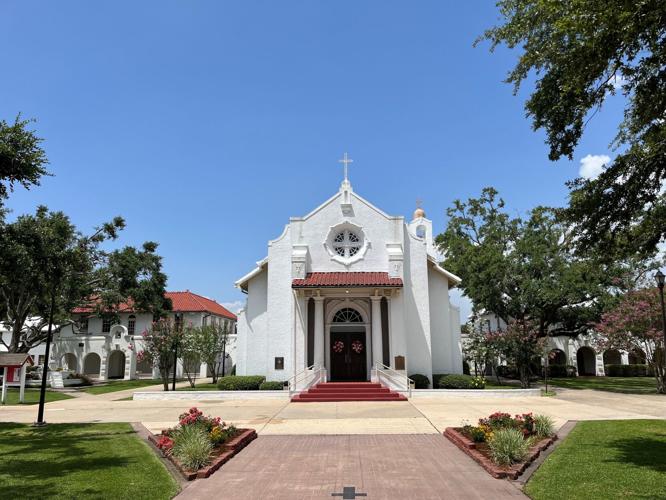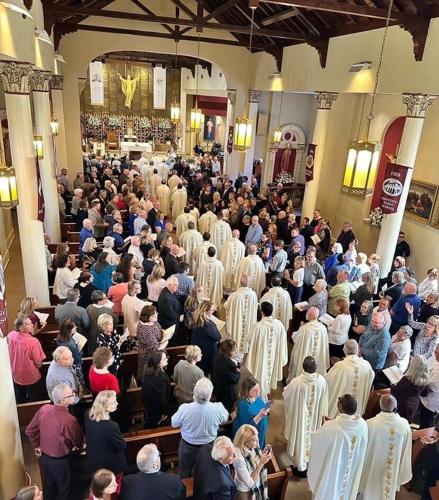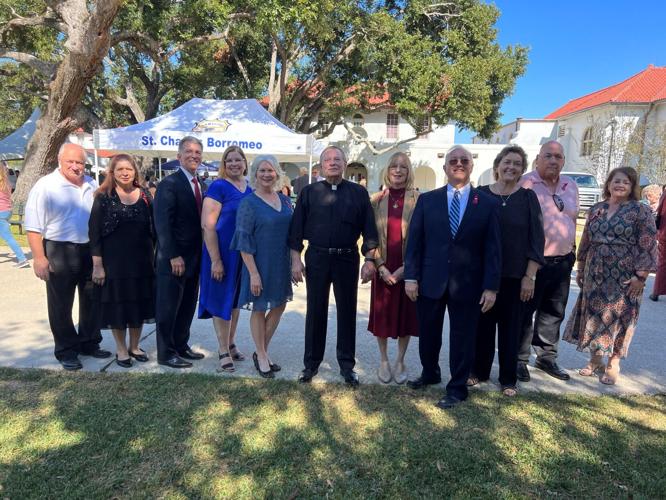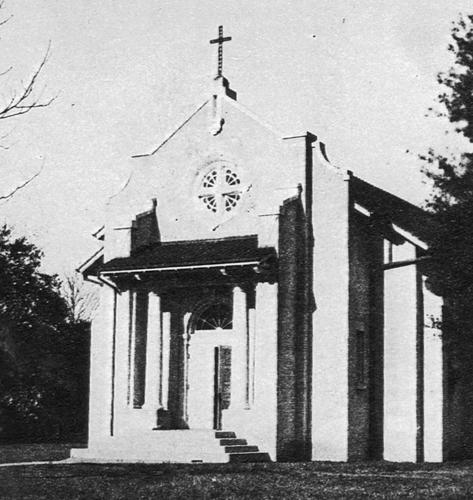St. Charles Borromeo Catholic Church in Destrehan recently marked 300 years of serving the community with a tricentennial Mass celebrated by Archbishop Gregory Aymond and the unveiling of a new plaza near the cemetery grounds.
“It was a remarkable celebration to say the least,” said Louis Authement, who served on the church’s 300th Anniversary Committee. “We had a spectacular Mass, and after that we proceeded over to a newly constructed monument called Ascension Plaza, which encapsulates 300 years of church history.”
After the Mass, the church held a food fest with plenty of gumbo, jambalaya and red beans and rice.

The church is full for an anniversary Mass.
Ascension Plaza is a circular brick courtyard with a ribbon of blue glass bricks winding through the middle to signify the Mississippi River, which runs through the church parish. A timeline of events is engraved in the brick pavers, divided by centuries.
The courtyard wraps around a large pedestal topped with a statue of Jesus raising his hands to the air.
Behind the statue, a small glass alcove is a museum housing artifacts from the church's history. It includes a map of the area, a stainless-steel plaque listing all 38 of the priests who have served at the church, and a slice of an oak tree that stood in front of the church for 160 years. The plaza is located exactly where the oak tree stood until about 10 years ago, when termites and hurricanes finally took their toll.
Started by German settlers
The parish is the second-oldest parish in the Archdioceses of New Orleans and was founded 25 miles upriver on the west bank by German settlers (living in a French territory) in 1723, just five years after St. Louis Cathedral was established in New Orleans.

The new Ascension Plaza is a circular brick courtyard that wraps around a large pedestal topped with a statue of Jesus. A ribbon of blue glass bricks winds through the plaza to signify the Mississippi River.
The small “church of the Germans” moved to the east bank a few years later to join French settlers in what is now Destrehan in St. Charles Parish, said Authement, who has been a member of the church since 1990.
He said faith and tradition bind this church to the community, with many parishioners tracing their ancestry back for numerous generations of parishioners.
John E. Campo, an architect from Destrehan who served on the 300th Anniversary Committee, worked with input from the committee to design the plaza. Campo, who has designed every new building on the church campus since 1990, said he wanted the plaza to be both informative and reflective.
“It’s been on my mind for the past three or four years that we should do something worthy of this occasion and commemorate who we are as a parish,” said Campo, who has attended St. Charles Borromeo for all 65 years of his life.

Shown are the chairpersons of the committees formed to organize the year-long anniversary celebration are, from left: Ronald and Janeen Rodrigue, Louis Authement, Mary Schmidt, Roxanne Fisher, Fr. Mixie Arcuri, Lauren Sensebe, Cliff Buller, Diane Rochelle, Hank St. Pierre, and Veda Dawson.
He said they built the plaza on the site where the oak tree once stood because it had long been a gathering place for the community. “Someone had the foresight to save a slice of that oak and it fit in perfectly with the story of the church.”
300 years history
The original church was a log cabin built on the west bank of the river in 1723 near what is now the town of Taft, Campo said. The church, which was known then as St. Jean des Allemans Catholic Chapel, moved to the east bank and its current site in 1740 as another log-cabin building with a cemetery.
The church became referred to as St. Charles Borromeo around 1748, and parishioners from both sides of the Mississippi River continued to attend, with many making the perilous journey across the river by boat to get to services.

The altar sits on a massive 400-years-old tree trunk that was shipped from Ortisei, Italy, and believed to date back to the time and locale of St. Charles Borromeo.
That church building burned in 1806 and was replaced by a single-room wood church that was painted red. Known as “the little red church,” Campo said that church stood for over 100 years and was a landmark for riverboat pilots. That church was replaced by the current church in 1921 and it was dedicated by Archbishop John W. Shaw.
“St. Charles Borromeo holds a lot of significance in my life,” Campo said. “Most of my family was baptized here, and my grandkids are the 10th generation of my family to attend here.” His grandparents were married in the church 99 years ago, when it was new.
When the church was expanded in 1978, the new walls were constructed from the old church pews. Today the church’s marble altar sits on a massive 400-years-old tree trunk that was shipped from Ortisei, Italy, and believed to date back to the time and locale of St. Charles Borromeo. The church parish currently has 2,000 registered families.
Emphasis on faith
Ronald Rodrigue, an administrative assistant with the church, said he’s not only proud of the new plaza, he’s particularly proud of the church’s outreach programs that help people who have left the church regain their faith.
“I’ve spent all 39 years of my life at St. Charles Borromeo,” Rodrigue said. “I started cutting the grass when I was about 10, left for college and came back, and I’ve been working for the church ever since.”
Rodrigue said the church was the first in the archdiocese to offer ACTS Retreats, which focus on helping lay people renew their belief in Christ. “We work with people who have left the church, some have been gone for decades, and we lead them back to the faith.”
St. Charles Borromeo has a cemetery on the church grounds, which is unusual for a Catholic church, Authement said. The original 1740s cemetery has the graves of the Destrehan family, who built Destrehan plantation, as well as numerous yellow fever victims who died in the 1850s.
“The pews have changed, the doors have changed and the whole building has changed at least four times, but the Mass has remained the same,” said Authement. “Faith is meant to be practiced, in part, out in the open in community and fellowship with your family and your community.”







